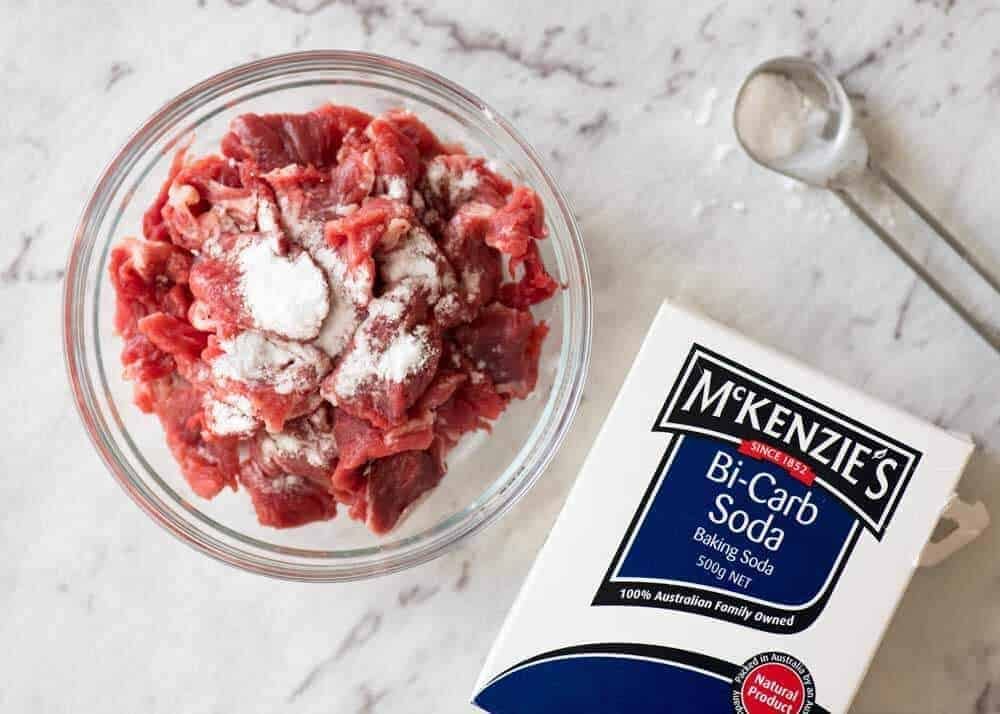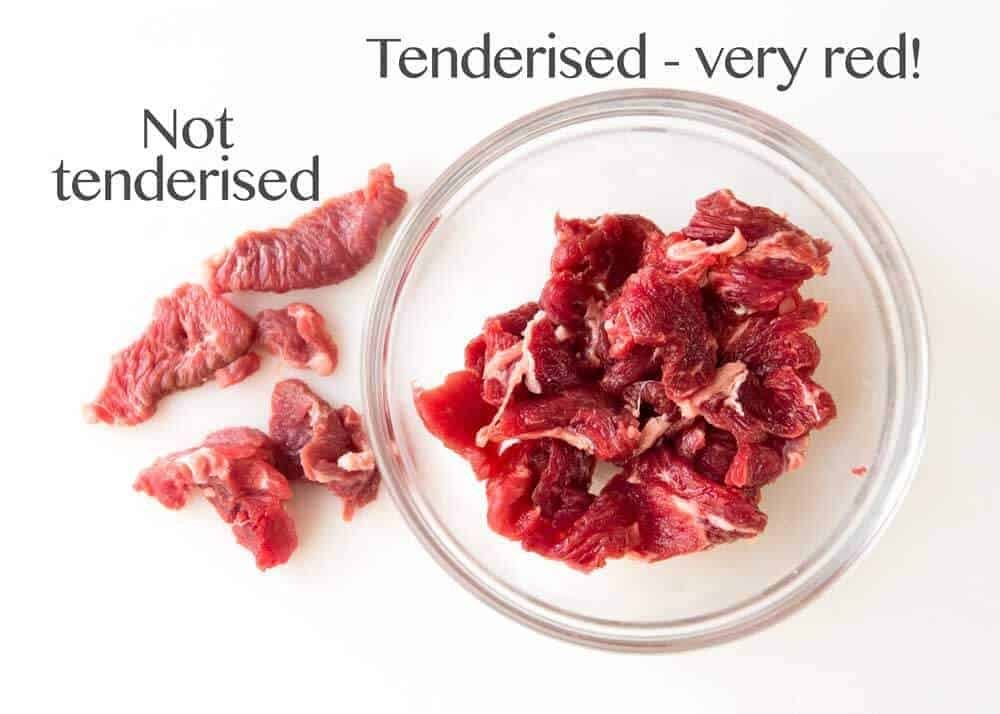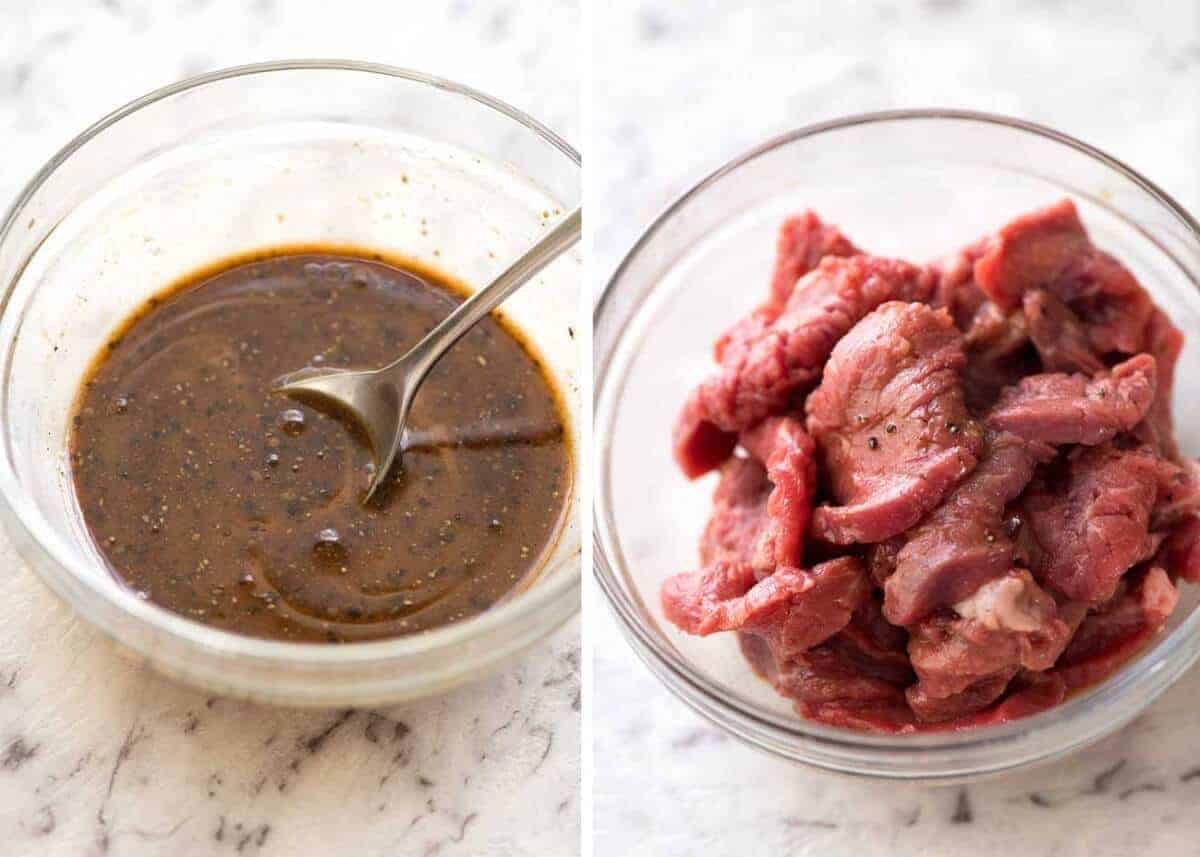This is how to tenderise beef with a Chinese restaurant method called “velveting beef”. Also used for chicken, it’s a simple, highly effective technique using baking soda that transforms economical beef so it’s incredibly tender in stir fries and stir fried noodles.
It’s a quick and easy method that any home cook can do, any night of the week. No deep frying, no special equipment. This is a game changer!


How do Chinese restaurants get their beef so tender??
Ever notice how the beef at Chinese restaurants is so incredibly tender, and how your stir fries at home are just never the same?
The secret is tenderising the meat. It’s called velveting beef.
Your cheerful local Chinese restaurant is using economical stewing beef to make stir fries with ultra tender strips of beef by tenderising it!
How to tenderise beef – easily!
There are a few methods, but this is the easiest way:
- Sprinkle 3/4 tsp baking soda (bi-carbonate soda) on 250g / 8oz sliced economical beef cuts
- Toss with fingers, leave for 30 minutes
- Rinse, pat off excess water
- Proceed with stir fry recipe. It can be marinated with wet or dry seasonings, or cooked plain. The beef will be really tender and soft, “velvet’ like. Just like in stir fries made by your favourite Chinese restaurant!
Other tenderising methods include marinating in a cornflour/cornstarch sludge then frying in oil before using in the stir fry, chemical tenderisers and egg white marinates. The baking soda method is the simplest for every day purposes and just as effective which is why it’s the method I use.

Beef cuts to tenderise
These are the best cuts of beef to tenderise:
economical steaks* – any type, like good value rump, porterhouse, sirloin, round bottom etc. that are otherwise quite dry when used in stir fries;
chuck and similar cuts of beef used for stews – this technique will tenderise the beef perfectly, however, by their very nature, stewing cuts of beef don’t have as strong a natural beef flavour as steaks. However, I’m fine with that because stir fries always have great sauces!
* It sounds counterintuitive to tenderise steaks because one would assume if beef is sold labelled as “steaks”, that indicates they’re good for quick cooking (eg grilling) so it should be good for stir fries. But it’s not – even steaks range from economical to high quality. You can use any high quality (expensive) steak in stir fries without tenderising (which is what fine dining Asian restaurants do). Use this tenderising technique on budget steaks, not expensive steaks.
Tenderising time
Tenderising time differs for different cuts of beef. Here’s the general rule of thumb I’ve come up with based on all the beef I’ve tried:
Chuck beef, gravy beef, oyster beef and other traditional stewing beef – 30 minutes
Economical steak cuts (eg. cheap rump, hanger) – 20 minutes
Blade, bolar blade – 40 minutes
Brisket – the only cut I don’t recommend, haven’t been 100% happy with outcome
If you’re unsure for your cut of beef, go for 35 minutes. Even when I under or over tenderised, it was still tender and juicy. You’ll quickly figure out the best marinating times for your preferred cuts of beef – just adjust up and down by 10 minutes at a time.
Word of caution: The beef will turn freakishly bright red. See?
Don’t be alarmed – that’s just what happens. In fact, if you put your ear very close to the beef, you’ll hear faint fizzing – that’s the baking soda at work!

Marinating Tenderised Beef
After it’s been tenderised, go ahead and marinate it in whatever you want – wet sauce or dry seasonings. Because we’re using thin slices of beef here and it’s been tenderised, we don’t need to marinate for long. Even 10 minutes will suffice.
Also, stir fries have the benefit of glossy sauces coating the beef so that’s another reason why we do not need to marinate it for long.
Pictured below is the stir fry sauce / marinade for Chinese Beef and Broccoli.

How to cook tenderised beef
Tenderised beef can be stir fried the traditional way – hard and fast on a hot stove in mere minutes – or even deep or shallow fried in oil like in this Crispy Mongolian Beef (pictured below).
Whichever way you cook it, the beef comes out much more tender and juicy than even expensive cuts of beef like beef tenderloin!
What does tenderised beef taste like?
The flavour of the beef is not affected by the tenderising. So the beef flavour will only be as good as the cut you use.
Tenderising affects the texture not the flavour of the beef. It has a “velvety” texture. The fibres are softened so you get less “meaty” texture, which is why I only use this technique to tenderise strips of meat and not cubes or steaks which would be a bit too eerie!

Why tenderise beef?
Tenderising beef enables you to make fast-cook beef recipes using economical cuts of beef that usually require slow cooking to break down the tough fibres, like in Stews. And it stays tender even if you overcook the beef!
What to make with tenderised beef
Because this is a Chinese restaurant method, I’m sharing this with stir fries like Beef and Broccoli and stir fried noodles in mind. Build your own stir fry using my All Purpose Chinese Stir Fry Sauce or Peanut Sauce for stir fries!
You can also use tenderised beef in place of chicken or pork in any of the stir fries.
But don’t limit yourself to just Chinese recipes! The plain tenderised beef isn’t flavoured, so it can be used for any recipe calling for strips of beef that are cooked quickly, such as Beef Stroganoff.
If you try this tenderising technique, I’d love to know what you think! – Nagi x

Hungry for more? Subscribe to my newsletter and follow along on Facebook, Pinterest and Instagram for all of the latest updates.

How to tenderise beef (velveting beef)
Ingredients
- 250 g / 8 oz stewing beef or other economical beef cuts (Note 1)
- 3/4 tsp baking soda / bi-carbonate soda (Note 2)
Instructions
- Slice beef thinly against the grain. (Note 3)
- Place in a bowl. Sprinkle over baking soda, toss with fingers to coat evenly.
- Refrigerate for 30 to 40 minutes. (See Note 1 for different cuts)
- Rinse beef well with tap water. Shake off excess water, then use paper towels to blot away excess water (doesn't need to be 100% dry).
- Proceed with recipe of choice. Beef can be marinated or seasoned before cooking, stir fried or deep fried, and it will be soft and tender, “velvet” like. Use for Stir Fries, Stir Fried Noodles, Beef Stroganoff and any other recipe calling for quick-cooked beef strips.
Recipe Notes:
1. Beef cuts – Use this for stewing cuts and to improve the tenderness of economical steaks. It will work with any cut of beef but is obviously wasted on expensive beef like tenderloin or high quality, well marbled fillets and rib eyes. Tenderising time differs for different cuts of beef. Here’s the general rule of thumb I’ve come up with based on all the beef I’ve tried:
- Chuck beef, gravy beef, oyster beef and other traditional stewing beef – 30 minutes
- Economical steak cuts (eg. cheap rump, hanger) – 20 minutes
- Blade, bolar blade – 40 minutes
- Brisket – the only cut I don’t recommend, haven’t been 100% happy with outcome
Nutrition Information:
Life of Dozer
This is the only beef he’s getting today… 😂

I missed the part of using 3/4 teaspoon, used way more and it’s all I can taste! Def will try again
Oh no Amanda!!!
Ive used the velveting of beef for about a year now..saw it on a website and I think I used the cornflour, and egg white mix but will also try the baking soda one. Great tip and now Im going to try your ‘Charlie’ sauce tonight.
Wow, I can’t believe it’s taken me this many decades of cooking – and cooking well – to learn this simple and very effective method of re-creating the perfect “Asian restaurant” stir-fried beef! Worked like a charm. Also made your Charlie sauce. 🙂 Thank you!
You’re totally converted Hanna! – N x
Hi Nagi, I was wondering how you would tenderise chuck steak for a stew? do you need to slice up the meat into strips for this method to work or can you leave the steaks whole? Thanks
Hi Nicole, generally stews are cooked for a long time so the beef is tender and you wouldn’t need to pre-tenderise it – N x
This works amazingly! Such an awesome tip, i had often wondered how chinese takaway got their meat so tender 😂
I am wondering what you think the maximum time is to leave the beef in the bicarb? I did it for 40 mins but im wondering if i leave it longer will the bicarb penetrate the beef even further?
Thank you so much for sharing!
This recipe is a life lesson. Things you should never forget. Works like a charm.
Yes totally Michael!
My asian stir fry nirvana has long been the tender velvety meat and it’s long avoided me. Last night tried this technique and it worked first try. Thanks SO much. Perfect
I’m so glad it worked for you Tony! You’re converted now!
Hi Nagi, just a query
you say 3/4 tsp baking soda
is that 3 or 4 tsp or 3\4 of tsp
thanking you Daryl
Hi Daryl, thats three quarters of a teaspoon, not 3-4 teaspoons – N x
This is amazing, you are amazing Nagi! Thanks!
Aww thanks so much Sasha!
I have tried 1 tsp of bicarb with 500gm rump and then cooking after 30mins. The beef is still the same and I get foaming in the wok and a brown residue stuck to the bottom. I am rinsing the meat and drying before cooking but this keeps happening. Is this normal?
Hi Matt, is the rump sliced when you velvet it? You can let it sit longer if you’re not finding the meat tender enough. If you get foaming in the pan it sounds like the bi carb isn’t completely rinsed off – N x
This velveting tip has revolutionised my stir fries!! I cannot get over what a difference it makes. It really turns it into a restaurant quality dish. My family are thrilled too!!. Thank you!!
this tip is awesome!! thankyou!!
It’s a game changer isn’t it Laurie!!
Do you mean do not tenderize
cubesteak or do not tenderize cubes OF steak? Lol I want to stir fry my cube steaks tonight.
Hi Vicki, I tenderise strips of meat – not cubes or whole steaks (hope this clarifies) – N x
Thank you very much for sharing your knowledge. With your permission, i may use and share these knowledge in my cooking demo. I find it very important to share this. Thank you very much.
Tried this method of tenderizing beef today and was so happy with the results! I used a package of “stir fry” beef from the grocery store (I had frozen it), always a mix of different cuts, and it’s always ended up being tough in my recipes. Not this time! Terrific. Thanks so much for this tip! It’s a game-changer.
Hello, you are a great cook and a local girl to boot…thank you for sharing. I have read in comments that lamb can be velveted can this be used for pork as well? How do you tenderise cubed or steak cuts
Hi Risky, you can tenderise most meats with the same technique!
Hi Nagi thanks for you reply. You mentioned in your post that the texture of velveting cube steak is wrong…to be certain that we are on the same page…what method if any do you use to tenderise cubed meat or a piece of steak. I have used the salt osmosis method but guess what it ended up to salty🙄 Off topic..i am going to make your Mongolian beef tonight as my taste buds went crazy recalling frequently ordering this dish when I was a lad, thank you so much for sharing.
You can tenderize chicken and pork chops in a solution of 1 tsp. salt, 1 tsp sugar in a cup of water. Leave it overnight or up to 2 days.
thanks for the disclosure of how to tenderize meat like Chinese restaurants do, I´ve always been curious about the taste and texture
Have been using your method for ages now and it works a treat, lamb, beef and chicken cuts for our quick mid week stir fries.
Yesssss! 🙌
Best advice ever for tenderising meat! I’ve been doing it this way for years and it is the best way to get Chinese restaurant-style tender meat at home.
Awesome Tamarra!
Love your practical advice and recipes! Awesome job.
Thanks so much Nancy ☺️
I recently read your method of tenderizing chicken the same way. This has been a lifesaver! No more tough chicken. Used this method in Chicken Cacciatore last night and it was delicious. Thanks!